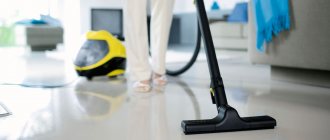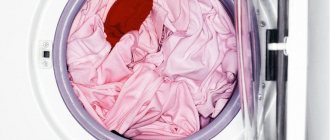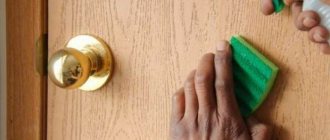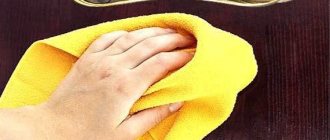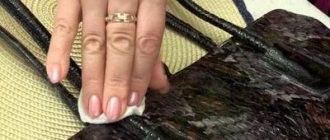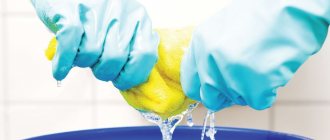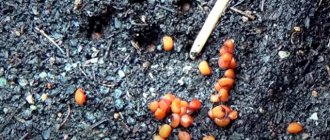Laminate is an affordable, attractive in appearance and quite practical floor covering. As a rule, material of class 32 or 33 is used in a residential apartment; it is wear-resistant and lasts a long time, provided that the laminate is cared for correctly. Let's figure out how to take care of the floor and what products are best to use.
Features of the material
First of all, you should get acquainted with the properties of the material - this will allow you to understand how it should be handled and what products are best to use to care for laminate flooring.
Laminate is of artificial origin, each coating element consists of several layers that perform a specific function:
- Stabilization. This layer is most often made of kraft cardboard.
- Ensuring rigidity. This function is performed by high-density fiberboard.
- Decor. To give the material an attractive appearance, paper is used on which a design is applied. The most commonly used pattern is one that imitates the surface of wood.
- Protection. The polymer film protects the material from moisture and other external influences.
Advice! It is very important that caring for the laminate does not damage the protective coating. Therefore, it is prohibited to use hard cleaning brushes and laminate care products containing abrasives.
And more life hacks - how to wash laminate flooring without streaks.
- For laminate, it is good to use rags from the Red Cat company at a cost of 125-150 rubles, you can see it in the Feed.
- Wring out the rag thoroughly. Laminate does not like a lot of water.
- It’s good when you can afford a mop or floor rag from White Cat. A lot of people are delighted. Vileda rags are also great for cleaning laminate floors.
- It is better to wipe along the boards, not across them.
- From the far corner of the room to the door.
- Change the water in the bucket often. Laminate loves clean water.
- Cap for a bucket of water with products for Grass, Pronto or Glorix laminate flooring.
- Sometimes add a little olive oil to your floor cleaning water. This is how you feed the tree.
- A wax pencil can effectively smooth out small scratches on the surface.
- Sometimes add half a glass of 9% vinegar to the water. There will be shine and disinfection.
- By the way, Grasse also has floor rags. Good, but not cheap. When you go buy household chemicals for your home, feel them.
How laminate care depends on its wear resistance
Depending on the method of formation and composition of the protective layer, the wear resistance class indicated in the marking is determined. The first number in the marking indicates the purpose of the material:
- the two denoted material for household use;
- three – intended for commercial use.
Recently, manufacturers have abandoned the production of material for household use, as consumers prefer to buy a more wear-resistant coating option.
The second number in the marking indicates resistance to mechanical shocks; it is determined by the density of the supporting layer. Indicated by a number from 1 to 4. Abrasion resistance is determined by a number from 3 to 6, which appears after the letter AC. For use in residential premises, two types of material are most often used:
- 32 classes (wear resistance degree AC4);
- 33 classes (wear resistance degree AC5).
The difference between material 32 and 33 classes is not only the increased wear resistance of the latter, but also its better resistance to moisture. Thus, class 33 laminate flooring can be washed frequently with water without damaging the condition of the material.
Wear resistance and moisture resistance classes
The laminate class is regulated by Standard EN 13329 and can be determined by digital markings.
- Laminate of classes 21-23 economy class has been discontinued, but it can be found in some apartments. It does not have high wear resistance and is afraid of water. Laminate class 21-23 can only be used in rooms without high load - bedrooms, pantries, dressing rooms.
- Laminate class 31 with wear resistance index (AC3) is intended for residential premises with low traffic; it is usually used in finishing a bedroom, nursery or living room. Not moisture resistant, subject to abrasion in walkable places: doorways, corridors, so it is better to protect it with rugs.
- Laminate class 32 (AC4) is resistant to abrasion, it can be used in rooms with heavy foot traffic: kitchen, hallway, children's room. It is also not moisture resistant; excessive wetting of the coating when washing should be avoided.
- Class 33 laminate (AC5-AC6) belongs to commercial coatings; it is abrasion-resistant and moisture-resistant, withstands frequent washing and high air humidity. It can be used in any room.
Application of different classes of laminate
Note! The frequency of wet cleaning and recommended methods of protecting it depend on the class of the laminate!
What do the images on laminate packaging mean?
Rules of care
To maintain the attractive appearance of the coating, you need to know and follow the rules for caring for laminate flooring. Moreover, they are simple. Necessary:
- regularly clean the floor from dust and dirt;
- If stains appear on the coating, remove them using approved methods;
- correctly choose and use household chemicals to care for laminate flooring.
These are not waterproof floors, so any spills must be cleaned up quickly. When wet cleaning, use a slightly damp cloth to avoid leaving wet marks.
Do not use a wet mop that absorbs detergents, as the contents may seep under the laminate, causing it to warp and lose its shape.
Floors can wear down and become warped from the use of harsh cleaning devices, so it's a good idea to keep squeegee brushes and similar items out of the closet. It is necessary to clean with a brush and a soft broom - the bristles should sweep away dirt without damaging the surface.
Furniture should never be pushed or dragged across the floor as this can cause damage to both.
If damage does occur, for example a minor scratch, this does not mean that the bar needs to be replaced immediately. Specially equipped stores offer repair kits that can mask this problem.
Problem solving
No matter how durable the laminate is, various minor troubles can happen to it during operation. Still, the floor can withstand considerable loads: heavy furniture, restless children, adults constantly busy with household chores.
- Stains from persistent alcoholic drinks, such as wine or liquor, can be easily removed with warm soapy water. Wipe chocolate, fat and spilled juices with products with a neutral pH factor; you can use regular shampoo or shower gel.
Wine and liquor can be easily removed from laminate flooring with warm soapy water.
- Have you noticed that there is chewing gum or drops of candle wax stuck to your laminate floor? Make sure they are set and remove them with a wooden scraper.
- If the kids decide to leave their mark on history by capturing it with felt-tip pens, pencils or a marker on the laminate floor, don’t worry. All this can be easily wiped off with acetone solvent or methyl alcohol. But do not forget that these products must be diluted with water in a ratio of 1 teaspoon of alcohol or solvent to 2 tablespoons of water. The same goes for ink, lipstick and shoe polish.
After removing stains, wipe the surface with a solution of 1 tablespoon of 9% vinegar per 5 liters of water so that the floor regains its former shine.
Restoration of scratches and chips
It’s worth talking about products such as wax crayons, paste and restoration varnish for laminate flooring separately. You can purchase any of them at a specialized store. It is advisable to take care of this immediately when purchasing laminate, so you will save time. In addition, you need to have a sample of the coating with you so as not to make a mistake with the color.
You can buy a complete set for laminate repair, in which you will find convenient spatulas and shovels, as well as all the necessary materials.
A wax chalk is suitable for treating minor scratches and abrasions. It consists of wax, paraffin and dye. The work flow is as follows:
- Thoroughly clean the laminate surface from dirt, grease and dust and allow to dry.
- Move the chalk over the damaged area until the scratches are completely covered with the compound.
- After a few minutes, when the wax has dried, polish the surface with a dry cloth.
If the scratches are deep or chips have formed on the laminate, use a special wax paste of the desired color. The processing process is almost the same as in the previous case:
- Clean the laminate.
- Apply the heated paste onto the chip with a plastic spatula until it completely covers the damage.
- Remove excess product with a wet cloth.
- Wait for the paste to dry and polish the area.
Finally, you can coat the restoration area with a clear repair varnish for laminate flooring.
Photo gallery: materials for laminate restoration
The restoration paste must be warmed to a liquid state before use.
The sealant is useful not only when laying laminate flooring, but also for preventive maintenance
Applying wax paste to a scratch in the laminate is done with a small plastic spatula
Wax crayons are the easiest way to quickly restore abrasions and shallow scratches.
Regular laminate floor maintenance
At home, two types of cleaning are used - dry and wet. When caring for floors made of material of 31-32 classes, it is recommended to do wet cleaning rarely - once every 3-4 weeks, since this type of coating is sensitive to moisture. But for floors covered with class 33-34 laminate, more frequent wet cleaning does not harm.
When washing with just water, stains often remain on the floor surface. Therefore, it is recommended to use special laminate care products. Instead of household chemicals, you can use vinegar (a spoonful of 9% vinegar per five liters of water). After washing, the floor must be wiped dry. There is no need to use mastic or wax to rub the floor surface.
Restoration activities
Sometimes minor damage appears on laminated panels, which can be eliminated or at least disguised using simple operations:
- To disguise small scratches, special wax pencils are used. Excess wax paste is removed with a dry cloth.
A wide range of colors allows you to choose a wax pencil for a specific type of laminated panels - For light-colored panels, you can use regular wax.
Adviсe! It will not be possible to mask scratches with varnish - the damage will become even more noticeable. It is not recommended to use mastic used to care for parquet for continuous treatment of laminate flooring and elimination of local defects. This is explained by the fact that parquet mastic is designed for an absorbent material such as wood. It forms unsightly streaks and stains on the surface of laminated panels.
Prohibited products
It is important to learn how to choose the right household chemicals to care for laminate flooring. Can not use:
- detergent compositions that contain abrasives, solid particles will scratch the protective coating of the material;
- You cannot use products that have an alkaline or acidic reaction to care for laminate flooring; you must choose neutral compounds;
- It is forbidden to use hard and, especially, metal brushes for cleaning the floor.
Advice! It is necessary to use soft sponges and microfiber cloths; they do not leave scratches on the floor.
You should not use wax-based mastics intended for parquet. A laminate floor is already smooth, but the use of wax mastic will make the coating slippery, like a skating rink.
Prohibited methods for cleaning laminate flooring
The use of certain products leads to damage to the laminated surface:
- Cleaning with powder causes mechanical damage to the floor covering.
- Substances containing alkali, ammonia and acid turn the floor into an unattractive matte finish without a protective layer.
- Products with bleach (for example, “Belizna”) corrode the floor, spoil the color of the laminate and destroy the laminate boards.
- Do not use hard, rough material, coarse sponges, or metal brushes: they leave small scratches on the surface.
Removing stains
No one is immune from the appearance of stains, so you should know what laminate care products can be used to remove them.
- Grease stains should be removed with soap, it is best to use dish soap;
- Stains from coffee, wine, juice should be washed using a solution of floor cleaner or a solution of washing powder with a neutral reaction;
- Stains from shoe polish or nail polish can be removed with a solvent such as acetone;
- Paraffin or wax stains are first removed mechanically using a plastic spatula. Then the area of contamination is washed with a soap solution;
- Chewing gum must first be frozen by putting ice, then removed with a spatula.
Heavy stains, such as paint or glue stains, can be removed with a special floor cleaner. These areas must first be wiped with a cloth soaked in acetic acid.
Do not use abrasive or alkaline products that damage the decorative surface.
You can remove not only stains, but also coating defects - scratches, chips. To do this, use a special wax-based product to care for laminate flooring. They fill the defect.
How to clean laminate flooring after renovation?
You should take care of protecting the floor in advance: cardboard and plastic film will protect the boards from contamination. Unfortunately, it is impossible to completely protect the floor during renovation. We'll tell you how to remove construction dirt from flooring below.
Primer
The easiest way to remove primer stains is to apply glass cleaner and wipe with a soft cloth. The old stain should be wetted with liquid primer and wiped off.
Polyurethane foam
This material hardens quickly and is difficult to remove. If you can’t get rid of the polyurethane foam right away, you can purchase a special product at a hardware store (for example, Penosil Premium Cured). But these compositions contain strong solvents, so you need to be careful when using it: read the instructions and test on an inconspicuous area of the floor.
A safer folk method is the pharmaceutical drug Dimexide. Dried foam should be carefully cleaned with a stationery knife, and then moistened with Dimexide and wet cleaning of the laminate. When working, you must protect your hands with gloves!
Wallpaper glue
Dirt from the surface can be easily removed with a soft cloth soaked in warm soapy water.
Construction dust
Remaining construction dust should be cleaned with a powerful vacuum cleaner. Particular attention is paid to baseboards and gaps between chamfers. Then wet cleaning is carried out with warm water. The cleaning products we wrote about earlier help to wash laminate flooring without streaks.
Paint from laminate
Ethyl alcohol will help remove the paint. White spirit or acetone will remove drops of oil-based paint, but it is important to ensure that they dissolve the paint and not the laminate.
Silicone sealant
The hardened sealant is removed carefully using a utility knife. The main thing is not to touch the surface of the laminate. You can also use a plastic scraper. But the most effective way is a special solvent from the store. It removes hardened silicone without harming the floor.
Marker
Traces from a marker or felt-tip pen can be smeared with toothpaste and then wiped with a dry rag. White spirit is suitable for more difficult cases, but should be used carefully.
Scotch
If there are sticky traces of tape left on the floor, they will be removed with a special Mr. Proper detergent, vodka or alcohol. There is also a special product “Antiscotch”, but its price is quite high.
Restoring the shine of a laminate floor
The best way to maintain shine is regular cleaning. The better you care for your laminate flooring, the longer it will last.
Over time, rolled flooring collects dirt and loses its original shine. Instead of leaving your floors gray and dull, take a little time and effort to restore their shine.
Dirt can be easily removed with a rag and brush. Solid particles and small stones must be carefully cleaned as they can scratch the laminate surface. Once the dust and debris have been removed, you should use a cloth mop to dry the floor.
If cleaning is not done on time or done poorly, the laminate floor will become covered with plaque. It can build up over time from cleaning products and is more difficult to remove than regular dirt and debris.
To remove plaque without damaging the laminate, you need to pour a little vinegar on a clean cloth and wipe the problem area with it.
If removing the deposits doesn't make your laminate floor shiny again, the floor surface is probably worn out. In this case, one or two layers of varnish can be applied to recreate the original look.
Housewives reviews
If the laminate is not perfectly smooth in texture, but appears to have chips in it, over time dirt gets clogged there, especially in frequently used places (on walkways). You can only see it when you bend down and look closely, but when you wash it, you can see that the floor is cleaner. This cannot be avoided, even if a special liquid is used. <…> Personally, I eliminated this issue with oven gel. Did you cover the floor with a dish sponge, the soft side? and washed it off with water. Where it was not washed off, use the same sponge, only the other side, rough, do not press too hard. I warn you, you need to check it on a piece of laminate. I passed the test, so I did it this way.
Irina
https://vopros-remont.ru/pol/chem-myt-laminat-pravilnyj-uxod/
Our color is bleached oak, I tried to wash it with chemicals (from the cheapest to the most expensive), an invisible coating remained, after walking on which there were already visible marks and stripes. Now I just wash it with water and that’s it - no problems. I just wash it in two stages: first it’s wet (as if I’m wiping off the dirt), then I pass it dry with a foam mop - and everything is ok)))
K
https://www.babyblog.ru/community/post/housedesign/1694416
I heard that there are special products for cleaning laminate flooring. And then in a household chemicals store I saw this “Emzal laminate”. There was no time to look for something else; the first thing I saw was what I bought. It says on the bottle that it protects the seams, and I think that this is the main thing, because over time, a kind of emptiness forms between the boards, as if the laminate does not fit tightly together (according to the stories of friends). I add 3 caps per 5 liters of water (of course, not in exact volume, but by eye) and wash the floor. The floor is truly streak-free, smooth and clean after washing. And there is a pleasant, mild smell in the house.
mary1225
https://irecommend.ru/content/zashchita-shvov-ot-vlagi
I wash laminate flooring with a mop with a Velcro cloth and regular clean water without any additives. There have never been any divorces. I didn’t even think that people bothered about stains on laminate flooring :))
Juli*
https://38mama.ru/forum/?topic=36451.0
I would like to give advice from my own practice. The salespeople at the store where I bought laminate flooring taught me. Laminate flooring should be washed with water, in which you need to dilute a teaspoon of fabric softener. The water becomes soft, after washing there are no streaks left, and the laminate looks like new.
Oksana
https://polaremont.ru/ukhod/shvabry-dlia-laminata-vidovoe-raznoobrazie-i-pravila-ekspluatatcii
Appearance of scratches
Even the most proper care of laminate flooring is unable to protect it from damage. Due to the fact that the top layer is quite thin and delicate, scratches can form on the laminate over time - both large and many small ones.
Damage can occur as a result of damage from small grains of sand, especially at the front door, sharp heels, as a result of moving heavy furniture around the room or falling objects, and so on.
There are several ways to remove scratches from laminate flooring.
How to remove small scratches
If the damage is superficial, you can use a wax pencil of the appropriate color. Their color palette is not very diverse, but in the presence of shallow damage, a perfect color match is not required.
Wax pencils are available in the same stores as laminate flooring. Use a pre-moistened soft cloth to remove dirt and dust from the scratch, and then paint it over its entire depth and length. Finally, carefully polish the painted area with a cloth.
Removing serious defects
Deeper scratches, dents, chips and cracks allow moisture to enter and gradually destroy the board. Therefore, if they are not eliminated, then over time the lamella will have to be replaced.
Large defects can be corrected with a special putty, which manufacturers produce in a variety of colors. It is made taking into account the composition from which the lamellas are made, so it fits perfectly to them. With its help, you can eliminate cosmetic defects and protect the laminate from moisture and debris.
So, caring for laminate flooring is not particularly difficult. However, you need to know how to properly clean so that the coating retains its attractive appearance for a long time and serves for a long time. The main task is not to use products and tools that could damage the protective film of the material.
Damage and its elimination
Despite its high wear resistance, over time, abrasions, small and deep scratches, and chips appear on the laminate. Damage must be repaired in a timely manner; this will protect the laminate from further destruction, water getting into the base and, as a result, from deformation.
Laminate flooring swollen due to damage to the protective layer
To remove small scratches, use wax crayons or retouch markers. They allow you to paint over scratches and restore the water-repellent properties of the surface. A wide range of color correction products for laminate allows you to accurately select the shade. Ready-made sets are also sold, including 3 or more shades of the desired color; by mixing them, you can achieve complete camouflage of damage.
Laminate restoration kit
Advice! Take laminate cuttings with you to the store - this way you can most accurately select the shade of the corrector. If you are in doubt which of two similar shades to choose, choose the lighter one, it is less noticeable against the background of the rest of the floor
How to remove a scratch from laminate flooring using a wax crayon:
- Clean the floor surface with a vacuum cleaner to remove small particles of sand and dust. If necessary, degrease the damaged area with alcohol;
- Apply chalk of the desired color to the scratch;
- Rub the wax thoroughly with a soft cloth until the scratch is completely rubbed out;
- remove any remaining wax with a soft cloth.
Removing scratches on laminate flooring using a chalk
Wax has water-repellent properties, so the repaired floor can be wet cleaned. Over time, the wax grout may need to be renewed.
How to remove a scratch using a retouch marker:
- Vacuum the area of the scratch or chip, and if necessary, wipe it with a cloth soaked in alcohol;
- shake the marker well for 10 seconds;
- press its rod inside the marker until the correction compound appears;
- fill the crack with corrector in one or several layers;
- remove excess product.
Retouch marker for laminate
After using the marker, the damaged area can be varnished to completely restore the protective layer.
The deepest scratches and large chips are restored using wax or paraffin-based putty; it is sold both separately and in repair kits. Apply the putty while heated; for heating, use a special battery-powered soldering iron; it is included in the repair kit, as well as a grout spatula and polishing cloth.
Table 3. How to repair a scratch on laminate flooring using putty.
| Steps, photo | Description of actions |
| Step 1 | Clean the restoration site from dust and dirt using a vacuum cleaner. Fatty stains must be removed with alcohol. Choose putty of suitable shades from the set. Turn on the soldering iron included in the repair kit and wait until it warms up. |
| Step 2 | Carefully melt a small amount of putty and apply it to the scratch. If the scratch covers an area of several shades, apply putty of different colors, trying to repeat the pattern. Wait for the putty to harden. |
| Step 3 | Use a special spatula to remove excess putty. If necessary, apply a second coat. |
| Step 4 | Using a small amount of putty, draw in individual small details of the design. You can also use a retouch marker for this purpose. |
| Step 5 | Buff out the repaired scratch using the cloth included in the kit. |
| Step 6 | Cover the damaged area with waterproof varnish and dry. |
Video - How to repair a deep scratch on laminate flooring using hard wax
If the damage is so great that it cannot be restored, all that remains is to replace the damaged lamella. To do this, you will have to disassemble part of the floor from the nearest wall, and if partial disassembly is impossible, use the method described in the video.
Prices for wax crayons for laminate flooring
laminate pencil
How does the indoor microclimate affect laminate flooring?
An unnoticeable, but very important stage of floor covering care is maintaining a suitable microclimate in the room. Laminate, like many other wood products, requires special temperature and humidity conditions. Fortunately, it coincides with the most comfortable conditions for human living. The air temperature in a room with laminate flooring should ideally be 18–20 °C. Suitable relative humidity for flooring is 50-60%.
Temperature is not as critical a factor as moisture. High humidity is one of the worst (and, unfortunately, most common) enemies of laminate flooring. If you spill a puddle of water on the flooring and do not wipe it off for a long time, this will lead to swelling at the joints of the boards.
Laminate flooring that is swollen at the joints is difficult to fix - it’s easier to replace damaged boards
If the room itself is maintained at too high a humidity level, the load-bearing layer will deteriorate. This will lead to significant deformation of the coating. This is often popularly referred to as “raised laminate.” It is almost impossible to repair such damage.
A “bulging” laminate is not only unsightly, but also inconvenient - it’s easy to trip over it
How to extend the service life
Laminate is considered a rather sensitive and “capricious” floor covering, the service life of which any owner wants to extend. To do this, you need to follow a few simple rules:
- You cannot walk on the floor in spiked shoes, shoes with heels, or high heels; it is better to walk in soft slippers or barefoot;
- in places that are subject to daily traffic (near the sofa or bed, in the children's room, next to the front door), it is recommended to lay rugs or special silicone pads;
- it is necessary to constantly monitor the cleanliness of the surface, do not move heavy furniture, and quickly wipe away any water that accidentally gets on the surface;
- to install vases with flowers, you should use special stands or pads, which can also fit under the legs of furniture;
- promptly repair scratches and chips to avoid further damage to the coating.
Like any other material used as flooring, laminate has its own characteristics. The specifics of coating care are as follows:
- the laminated surface is resistant to prolonged exposure to water, so you must always wipe the floor dry after wet cleaning or accidental contact with any liquid;
- acid-containing, alkaline, abrasive cleaning agents, as well as metal tools, are not suitable for working with laminate;
- Before any treatment of the coating, you should first test the cleaning agent on an inconspicuous area to ensure that there is no reaction to the active substances;
- stains of any origin should not be soaked;
- cleaning products should not be left on the surface for a long time;
- drying of the coating should be done only naturally; do not use a fan, heater or hairdryer.
The main rule, the observance of which will ensure the preservation of the appearance of the laminate for many years, is careful use, systematic cleaning and compliance with the manufacturer’s recommendations regarding operation and maintenance.
Selecting inventory
Before you start wet cleaning, you should remember that not all products and methods that are successfully used for cleaning other coatings are suitable for laminate floors. Let's take a closer look at what a laminate floor is afraid of, and what equipment and cleaning products it reacts well to.
Strong friction with abrasive objects leaves scratches and abrasions on the surface of the lamellas. Therefore, brushes with hard bristles, metal sponges and mops with protruding parts are not suitable for washing them.
Are you planning to clean the laminate floor by hand or with a regular mop? Then you need to choose a soft fabric, for example: flannel, flannel, or use a special microfiber cloth. You can also use a squeezing mop with a foam sponge. They not only do not leave scratches, but also absorb water well.
Excessive moisture is another enemy of laminate. This is especially true for budget varieties. Therefore, to clean the coating, it is only conditionally possible to use the “assistants” of the modern housewife - a washing vacuum cleaner and a steam mop.
A washing vacuum cleaner sprays a significant amount of water across the floor, which can cause deformation of the slats. It is worth washing laminate flooring with this device in two cases:
- If the device has a water supply regulator and a sufficiently high suction power (at least 300 W) to quickly remove it from the surface.
- If the plates are treated with moisture-resistant impregnation and have a strength class of at least 32.
A steam mop essentially cleans using water, only in a gaseous state. In addition, the steam in this device has a temperature of 100°, and this creates an additional risk for the floor covering: the lamellas under the influence of hot water can rise and the protective coating can melt.
The steam cleaner is only suitable for laminate floors with adhesive joints and without a wax coating. In this case, the napkin for the nozzle is folded in half and variable steam supply is used.
After wet cleaning, the laminate is not left to dry naturally. It definitely needs to be wiped, so you will need an additional, soft cloth that absorbs water well.
Elimination of small defects
The appearance of scratches and abrasions is natural during the use of the floor covering. Together with the loss of the original appearance, such seemingly small defects can lead to more serious problems. If you examine the structure of the floor covering, you will see that the protective layer of melamine or acrylic is followed by decorative paper. Even if there is a small scratch, moisture will penetrate through it, which will gradually destroy the decorative surface.
In order to avoid radical measures to replace a separate board, you can use special wax. This is a composition, the use of which will help solve the following problems.
- Sanding small defects. The wax will fill the problem area, visually its layer will be indistinguishable against the background of the overall texture.
- Moisture protection. This natural material is highly moisture resistant.
How to choose the right wax pencil for laminate flooring? First of all, you need to decide on the shade. To do this, it is better to take a small piece from the board (usually left after installation) and select the optimal shade before purchasing. You also need to take into account that repair wax differs in the degree of softness. The harder it is, the longer the “patch” on the decorative surface will last.
The method of using a wax pencil is quite simple. The damaged area must be cleaned of dirt. Then, pressing on the pencil, rub the defective surface with little effort. The main thing is not to apply too much repair layer. After this, the surface must be polished with a dry cloth. This way you can effectively and quickly get rid of small defects.
Before caring for laminate flooring, you should carefully read the manufacturer's recommendations. They often contain a lot of useful information. This will also prevent you from using the wrong surface cleaning products. Their list can be found on the packaging box or directly on the manufacturer’s website.
Tips for care and use
- Try to stick to the “golden mean” when washing the floor: not often and not infrequently, so as not to spoil it with constant moisture or stagnant dirt.
- Do not walk on laminate flooring in heels. It is better to wear soft house shoes or go barefoot.
- Put pads on furniture legs to avoid scratching the floor.
- If liquid gets on the laminate, try to dry the area immediately with a dry, clean cloth.
- If scratches, dents, or chips appear, eliminate them immediately, otherwise complete destruction of the canvas will not be avoided.
- If you find severe contamination, remove it immediately. Dirt is quickly absorbed deep into the laminate and then cannot be removed.
